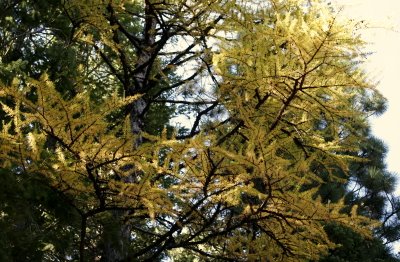
The Tamarack tree is a deciduous conifer that resembles other evergreens. It's pale green needles are soft and very short and grow in brush-like tufts on small knobs that grow along each branch. When the cold of autumn arrives, these pale green needles turn a beautiful golden color. These golden trees then dot the forest of evergreens with a beautiful, autumnal golden color. The tamarack stand in striking contrast to the other foliage of fall.
Fallen or dead-standing tamarack trees are highly sought after by gatherers of wood for fires. It's quality and duration make it one of the best for cutting and taking to valley homes for wood stoves or fireplaces. This tree is also useful for food and medicine. The tender shoots of spring cn be eaten when boiled and the inner bark of the tamarack tree can be scraped, dried, and ground into a flour. A gummy sap as sweet as maple syrup is also a quality of this tree and the sap can be chewed as gum.
Native Americans and herbalists say that the tamarack bark is useful as a laxative, a tonic and diuretic, and for rheumatism and skin problems. If gargled, it is said to ease the pain of a sore throat. Poultices made from tamarack's inner bark can be used on sores, swellings, and burns, or to ease a headache. Tamarack tea is an astringent and is useful for many purposes.
The tamarack shown is this photo stands guard by the front door of the cabin where we can enjoy it's beauty as it changes with the seasons.

No comments:
Post a Comment
Thank you for commenting on my blog post. I am always happy to hear from blog readers. Your words encourage and inspire me. I am glad you stopped by to share conversation, recipes, ideas, and thoughts on creating a welcoming home.